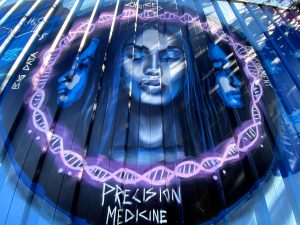 Why Diversity Matters
Why Diversity Matters
The central faces within our mural represent several aspects behind the creation of the mural, and the science behind the mural. Firstly, this mural was led by all women. Audifax, our artist, wanted to recognize the female leadership that made this mural possible, which spans science, art and business. We wanted the mural to celebrate the diversity of our community, and reflect the strong women of color within Madison.
This bring us to the science behind the mural and how diversity matters, and is critical to the strength and equity of future health care treatments. We represent three women, to highlight that Precision Medicine requires many people of diverse backgrounds to contribute to research. The two women on the side symbolize the group of people whose contributions to Precision Medicine research contribute to central woman’s strong health and empowered medical care.
With just one person’s data or one homogeneous group’s data, scientists cannot discover findings that are representative of all our community. Precision medicine is not looking at the average. And we are not just our genomes, we are a mix of our genes and environment together. This is why it becomes vital to include the diversity of people and places that make up our global community. Through this research, we will be able to better serve public health, and support advanced systems for medical treatments and preventions that are tailored to our needs.
However, it takes trust between community and researchers in order for communities to engage in medical research. Historically, people of color have not been a part of medical research aimed at promoting and protecting the quality of our lives. Lack of diversity within medical research has contributed to a lack of data, knowledge, services and tailored medical therapies for our diverse communities. Measuring molecular features, like the ones represented within the mural, in diverse populations is extremely important for interpretation of variation. For example, if only a single gender or ethnicity is measured to set a baseline, then another gender or ethnicity that may naturally have a higher level of a particular feature may be misdiagnosed as diseased, causing unnecessary intervention.
By expanding studies to include diverse populations, we are moving towards medical empowerment and more treatments that are built based on our diversity.
 Why Diversity Matters
Why Diversity Matters